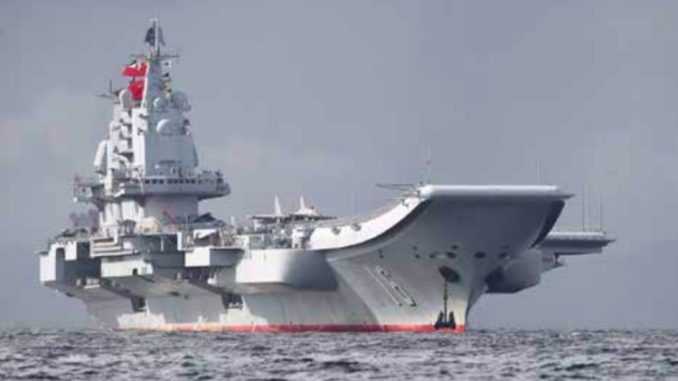The key foreign policy test for the New Zealand government during the next two years, writes former Defence Minister Wayne Mapp, is whether New Zealand can maintain the balance of its relationships with China and the United States.
Seven years ago, I was a Research Fellow at the Centre of Strategic and International Studies in Washington DC. Among my areas of study was the likely growth of China’s military power out to 2030. I knew this would be a critical determinant of New Zealand’s future Asia Pacific policy, and in particular the relationship with traditional friends and allies.
It was clear seven years ago that China was dramatically modernising its military forces, as China planned for the time that it would reach economic parity with the United States. This was expected to occur sometime in the 2020s. Seven years later China is on track to achieve parity within the next ten years.
With power comes influence. It is very clear that China now expects to harvest the fruits of power. The time when Deng Xiaoping could counsel his nation to “Never be a leader” is past. When Deng made that statement, China had just started its rise.
In any event it was a statement of tactics, not strategy. China would not lead when it couldn’t, it would wait for more propitious times. These times have now arrived. President Xi Jinping is clearly very determined that China will be treated as an equal.
The growth of Chinese military power illustrates the scale of the change of the last two decades, and the likely course of China’s approach to international relations for the future. The change in airpower illustrates the general trend. Twenty years ago, China did not have any modern air combat aircraft in the category of the SU 27. Today it has 1,000 such aircraft, including bringing the fifth gen J20 into service. By 2030, China will have over 2,000 fourth and fifth gen aircraft in service.
Similarly, China now has two aircraft carriers, and by 2030 is likely to have six carriers, four of them with catapult launching systems. They will be supported by up to 200 modern frigates and destroyers. The same story of rapid modernisation can be told in every major combat and support category.
In 2012, there was no inkling that China would establish three military airfields in the South China Sea by reclaiming atolls. Yet this was achieved in less than five years. These projects were probably among the world’s largest civil engineering projects at the time.
More than anything, the establishment of the South China Sea air bases changed the tone of China’s relationships in the Asia Pacific. They showed a China that would aggressively pursue its own interests, heedless of any reaction of its neighbours. The sheer increase in military capability shows that China is determined to be the pre-eminent actor within its immediate littoral area.
The contest for influence and power between China and the United States has been foreseeable for many years. It is possible that the election of President Trump sharpened the contest, but it was occurring in any event.
Democrats and Republicans are largely united on this issue. They may differ in tactics, but not on the goal. They share the aim that the United States should remain number one in the Asia Pacific. They expect their friends and allies will support them in this endeavor.
- Taiwan Loses Second Ally This Week to China
- Chinese Embassy hits back after US Ambassador to New Zealand's criticism of China
- New Zealand spies helped track down cyber-attackers on Australian Parliament
This poses a dilemma for many Asia Pacific nations, including those closely allied to the United States. Most of them have hugely benefitted from China’s growing prosperity, and they do not want this disrupted. At the same time, they want to preserve their defence ties with the United States.
These do not exist in stasis. As the contest between China and the United States sharpens, the United States has greater expectations from the defence ties it has with allies and partners.
Although New Zealand is not a formal ally of the United States, the defence and intelligence ties run deep, derived from shared history and culture. There is no prospect of New Zealand switching its strategic defence alliance to China, or even becoming non-aligned. Rather the key question that New Zealand policy makers are grappling with is, to what extent, if any, should New Zealand continue to strengthen its strategic relationship with the United States.
For the last decade New Zealand has been progressively rebuilding its United States relationship. This has been done without it being perceived as being antagonistic to China. In part this was because New Zealand strived to maintain balance by joining Chinese initiatives such as the belt and road. However, in the new environment of an emboldened China, and a less nuanced United States, can this balance be sustained?

First indications from the Labour – New Zealand First government are that there has been a subtle tilt toward the United States.
This was most evident in the 2018 Defence Strategic Policy Statement with its more critical tone about China’s role in the Asia Pacific. In November 2018, the GCSB indicated that Spark should not deal with Huawei in relation to the 5G network. This was seen by many commentators as being driven by New Zealand’s Five eyes partners. China may well have expected this outcome, and not be particularly concerned about it.
China does not expect New Zealand to switch strategic alliances or become non-aligned. But it does expect a properly respectful relationship. The sharper tone of the Defence Strategic Policy Statement did not meet that expectation.
During the years ahead, it is likely that achieving the appropriate balance between China and the Unites States will become more difficult as the contest between the two great Asia Pacific powers sharpens.
It is not yet clear that the government has deliberately embarked upon a policy of changing the careful balance that has been achieved over the last two decades. If that is the plan, then there are likely to be costs, particularly in the economic sphere.
- Chinese police herd hundreds of blindfolded, Muslim prisoners
- China gaffe: Where in the world is Jacinda Ardern?
- Hong Kong bans face masks after months of protests
- Taiwan cuts ties with Solomon Islands
Any degradation of the Chinese economic relationship is unlikely to be compensated by commensurate gains with the United States. After all, President Trump, in his first major act as president, withdrew from the Trans Pacific Partnership. This was intended to be New Zealand’s free trade deal with the United States. Thus far there has been no indication that it will be substituted with a bilateral trade deal, the apparent preferred approach of President Trump.
The key foreign policy test for the New Zealand government during the next two years is whether New Zealand can maintain the balance of its relationships with China and the United States. This balanced approach has served New Zealand exceptionally well over the last two decades, enabling New Zealand to maintain growth rates well above those that prevailed in the last quarter of the twentieth century.
Both the Prime Minister and the Foreign Minister need to have a comprehensive articulated policy around this fundamental question. Because the China – United States question is so important to New Zealand’s future, the nation needs to be assured that the government speaks with one voice on this issue.
It will be a very significant achievement for the Prime Minister and the Foreign Minister if they can navigate New Zealand with as much success as their predecessors, particularly given that they face far more challenging times.






